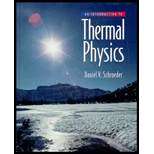
Aluminum silicate,
(a) Referring to the
(b) Now consider what happens at fixed pressure as we vary the temperature. Let
Although the entropy of any given phase will increase significantly as the temperature increases, above room temperature it is often a good approximation to take
(c) Taking
(d) Referring to the room–temperature heat capacities of the three form of
Want to see the full answer?
Check out a sample textbook solution
Chapter 5 Solutions
An Introduction to Thermal Physics
Additional Science Textbook Solutions
Biology: Life on Earth with Physiology (11th Edition)
Campbell Biology (11th Edition)
Organic Chemistry (8th Edition)
Chemistry: An Introduction to General, Organic, and Biological Chemistry (13th Edition)
Genetic Analysis: An Integrated Approach (3rd Edition)
- Fluids were sampled from surface manifestations within a geothermal system. Laboratory analysesresulted to the following concentrations: Silica quartz = 500 ppm Amorphous silica = 1000 ppm Sodium = 1000 ppm Potassium = 200 ppm Magnesium = 0.2 ppm Tabulate the possible temperatures of the geothermal system according to each geothermometer (inorder as presented). What do you think is the valid temperature range of the area? present yor solutions.arrow_forwardThe image shows the example of finding the number of vacancies in 1 cubic meter of copper (Cu) at 1000 degrees celcius (1273 k) considering the image data. Replicating the problem in the image, calculate the number of vacancies but at room temperature.Explain why there is such a difference in the number of vacancies at both temperatures.arrow_forwardSteady-state creep rate data are given here for some alloy taken at 200°C (473 K): ė, (h4) o (MPa) 2.4 × 10 3 53 2.7 × 10 2 71 If it is known that the activation energy for creep is 150000 J/mol, compute the steady-state creep rate at a temperature of 230°C ( 503 K) and a stress level of 46 MPa. h1 eTextbook and Media Save for Later Attempts: 0 of 3 used Submit Answer e to search aarrow_forward
- .Calculate the equilibrium concentration of vacancies per cubic meter in pure copper at 850°C. Assume that the energy of formation of vacancy in pure copper is 10eV. (b) what is the vacancy fraction at 800°C?arrow_forwardHelp me with this questionarrow_forward2.6 times that developed in the aluminum: f, 2.6f, Because P AJ Apanhola + A,J. (2.6) (0.5) () + (0.5) () 5000, we have f. 2777 lb/in. and f- 7220 lb/in.¹ (The nA, value is often called a transformed area; the steel is considered to have been transformed into a modified area of aluminum that is structurally equivalent.) To find fal deformations, fa/B. 2777/11,300,000 0.000246 and AL, L-0.00245 in =/ft ANA QUESTIONS 2.1. A force of P defined by the angle 0,= 75° to the horizontal acts through a point. What are the components of this force on the x- and y-axes? [See Figure 2.59(Q1).] Questions. 211- L/2- 2.2. The components of a force on the x- and y-axes are 0.50P and 1.50P, respectively. What are the magnitude and direction of the force? [See Figure 2.59(Q2).J Answer: 1.58P at 0,= 71.5°. 2.3. The following three forces act concurrently through a point: a force P acting to the right at 0, 30° to the horizontal, a force P acting to the right at 0,= 45° to the hori- zontal, and a force P…arrow_forward
- (1) For a gas that follows equation of state pV = f(T), show that дру 1 df V dT' (ӘТ V (N)₂ P ƏT = 1 df p dTarrow_forwardRadioactive decay of granite and other rocks in Earths interior provides sufficient energy to keep the inrerior molten, to heat lava, and to provide warmth to natural hot springs.This is due to the average release of about 0.03 J per kilogram each year. Find an increase in temperature for a thermally insulated chunk of granite that takes about 13.2 million years to change temperature. (Assume that the specific heat capacity c of granite is 800 J/kg. C. Use the equation Q=cmdeltaT.arrow_forwardi cannot get the answer of 1.4 x 10^3 kcal/h pls help mearrow_forward
- What's the answer to carrow_forwardThe temperature at state A is 20ºC, that is 293 K, what is the temperature at state D, in Kevin? Your answer needs to have 2 significant figures, including the negative sign in your answer if needed. Do not include the positive sign if the answer is positive. No unit is needed in your answer, it is already given in the question statement.arrow_forwardWhat is the bulk density of the dry soil?arrow_forward
 College PhysicsPhysicsISBN:9781305952300Author:Raymond A. Serway, Chris VuillePublisher:Cengage Learning
College PhysicsPhysicsISBN:9781305952300Author:Raymond A. Serway, Chris VuillePublisher:Cengage Learning University Physics (14th Edition)PhysicsISBN:9780133969290Author:Hugh D. Young, Roger A. FreedmanPublisher:PEARSON
University Physics (14th Edition)PhysicsISBN:9780133969290Author:Hugh D. Young, Roger A. FreedmanPublisher:PEARSON Introduction To Quantum MechanicsPhysicsISBN:9781107189638Author:Griffiths, David J., Schroeter, Darrell F.Publisher:Cambridge University Press
Introduction To Quantum MechanicsPhysicsISBN:9781107189638Author:Griffiths, David J., Schroeter, Darrell F.Publisher:Cambridge University Press Physics for Scientists and EngineersPhysicsISBN:9781337553278Author:Raymond A. Serway, John W. JewettPublisher:Cengage Learning
Physics for Scientists and EngineersPhysicsISBN:9781337553278Author:Raymond A. Serway, John W. JewettPublisher:Cengage Learning Lecture- Tutorials for Introductory AstronomyPhysicsISBN:9780321820464Author:Edward E. Prather, Tim P. Slater, Jeff P. Adams, Gina BrissendenPublisher:Addison-Wesley
Lecture- Tutorials for Introductory AstronomyPhysicsISBN:9780321820464Author:Edward E. Prather, Tim P. Slater, Jeff P. Adams, Gina BrissendenPublisher:Addison-Wesley College Physics: A Strategic Approach (4th Editio...PhysicsISBN:9780134609034Author:Randall D. Knight (Professor Emeritus), Brian Jones, Stuart FieldPublisher:PEARSON
College Physics: A Strategic Approach (4th Editio...PhysicsISBN:9780134609034Author:Randall D. Knight (Professor Emeritus), Brian Jones, Stuart FieldPublisher:PEARSON





